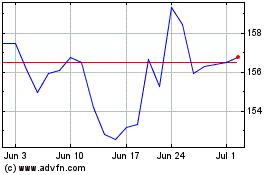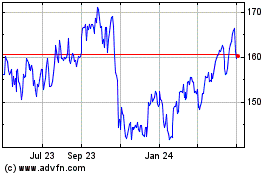Oil Prices Steady Ahead of U.S. Inventory Data
March 05 2019 - 5:20PM
Dow Jones News
By Dan Molinski and Sarah McFarlane
-- U.S. oil prices declined slightly Tuesday, sticking to a
narrow trading range as stock markets moved sideways and investors
awaited weekly government data on U.S. oil inventories.
-- West Texas Intermediate futures, the U.S. oil standard, ended
0.1% lower at $56.56 a barrel on the New York Mercantile
Exchange.
-- Brent crude, the global oil benchmark, closed 0.3% higher at
$65.86 a barrel on London's Intercontinental Exchange.
HIGHLIGHTS
Close Quarters: WTI has been trading in a tight range roughly
between $55 and $57 a barrel for the past two weeks, and prices
remained hemmed inside that band most of the session on Tuesday.
"The complex remains in a consolidation phase and while today's
push to above yesterday's $57 highs per nearby WTI offered some
solace to the bulls, upside follow through will likely require a
decided bullish surprise out of tomorrow's EIA report," said
analysts at Ritterbusch & Associates in a research note,
referring to the U.S. Energy Information Administration's weekly
petroleum status report.
Last week's EIA data provided just such a surprise, as the
administration reported a large and unexpected 8.6-million-barrel
decline in U.S. oil inventories for the previous week. But price
gains after that report stalled out quickly, leading some analysts
to question whether prices may soon fall back toward $50 a
barrel.
This week's EIA report is due Wednesday morning, and a survey by
The Wall Street Journal indicates crude stockpiles may have risen
by 1.6 million barrels last week.
The American Petroleum Institute, an industry group, said late
Tuesday that its own data for the week showed a 7.3-million-barrel
increase in crude supplies, a 391,000-barrel fall in gasoline
stocks and a 3.1-million-barrel decrease in distillate inventories,
according to a market participant.
China Slowdown: Oil prices had turned lower during the overnight
session after the world's second-largest economy cut its 2019
economic growth target to between 6% and 6.5% on Tuesday, lower
than the 6.6% it achieved last year, causing concern over the
outlook for Chinese oil demand. "The Chinese figures do matter, the
market is strongly focused on Chinese demand expectations," said
Hans van Cleef, energy economist at ABN Amro. While this was
negative for oil prices, a more supportive development has been the
progress toward a trade deal between the U.S. and China after
months of tension, Mr. van Cleef added. China and the U.S. are in
the final stages of completing a deal.
INSIGHT
Permian Push: Chevron Corp. and Exxon Mobil Corp. plan to
significantly ramp up production in the Permian oil field of Texas
and New Mexico that lies at the heart of the American fracking
boom. Exxon said Tuesday it would increase its Permian output to
one million barrels of oil and gas a day by as early as 2024, while
Chevron expects to more than double its Permian production to
900,000 barrels of oil and gas a day in the next five years.
"Both Exxon and Chevron are trying to one-up each other over how
fast they intend to grow there," said Stewart Glickman, energy
equity analyst at CFRA Research. "Why is this hard-baked patch of
earth relevant? Because the Permian Basin is on the verge of
hitting 4.0 million barrels of oil per day in supply, which, if it
were a country and part of the OPEC-Plus Consortium, would rank
fourth in size, after Saudi Arabia, Russia and Iraq."
AHEAD
-- The EIA releases its weekly petroleum status report at 10:30
a.m. ET Wednesday.
-- Baker Hughes releases its weekly rig count on Friday.
Bradley Olson contributed to this article.
Write to Dan Molinski at Dan.Molinski@wsj.com and Sarah
McFarlane at sarah.mcfarlane@wsj.com
(END) Dow Jones Newswires
March 05, 2019 17:05 ET (22:05 GMT)
Copyright (c) 2019 Dow Jones & Company, Inc.
Chevron (NYSE:CVX)
Historical Stock Chart
From Mar 2024 to Apr 2024

Chevron (NYSE:CVX)
Historical Stock Chart
From Apr 2023 to Apr 2024
